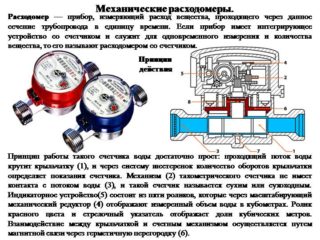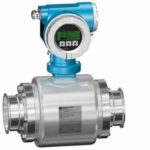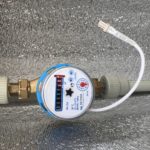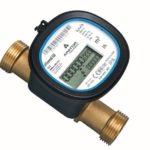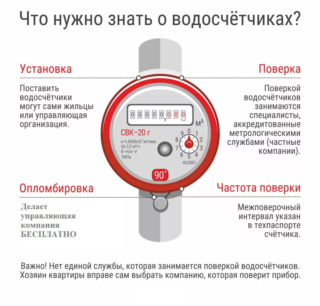With the regular increase in prices for utilities, it becomes relevant to control the consumption of the resources provided. This is especially true for drinking water. The installation of a water supply meter is regulated by the law of the Russian Federation. Such devices are not installed on stand-alone wells.
Definition and scope of water meters
As a result of using the device, the user can independently control the level of resource consumption: if you want to save money, reduce water consumption or allow you to exceed the limit previously set for a family.
Installing a meter in an apartment allows you to save up to 30-40% of the budget, in contrast to the payment of utilities according to the indicator averaged for one person.
Varieties of counters
First of all, SGV and SHV have a significant difference - the materials of internal elements. For a device for hot water, more stable components are needed, since exposure to high temperatures negatively affects the mechanism of the water meter.
Instruments are classified according to the way they work. There are such devices:
- Mechanical (tachometric). They work on the principle of rotation of the impeller, which is activated when moving through the device for the flow of liquid. In turn, the operation of the blades is influenced by a tachometer, which reacts to water. Subsequently, the counting mechanism displays information on the scoreboard. All mechanical water meters are additionally divided into multi-jet, single-jet and turbine. The positive aspects of tachometric counters are their non-volatility. However, due to the presence of movable elements, the device breaks down faster.
- Pulse devices with indicator. They can read the water flow by the number of pulses. They are pre-configured at the factory by the manufacturer. The most popular is the Pulse 15UI-80 water meter.
- Ultrasonic. They work on the principle of wave acceleration together with the flow of the transported liquid and then back. The water consumption is calculated from the difference that occurs with the formation of oscillations at the moment the flow overcomes the sensors. In total, the ultrasonic water meter has four elements - a calculator, a flow metering zone and two transmitters of working pulses. Each of them controls the ultrasound in its own way and first of all generates it. The readings of such a device are as accurate as possible, provided that the water supply pipes are clean from the inside. Serves as an ultrasonic water meter for up to 15 years.
- Vortex universal (SVU). Water flow meters have a special hermetic element and a pressure sensor in their design. The work of the counter is based on the principle of a vortex road. The water meter gives the most accurate data, but provided that only pure liquid (without impurities) passes through it. Such a device serves for about 8 years.
- Electromagnetic. They work on the principle of magnetic induction. It is water that plays the role of a conductor in them. It moves in the field of a magnet, forming a force. Its value, in turn, directly depends on the fluid flow rate. The magnetic field is generated by inductors. The data is displayed on the scoreboard.
Electromagnetic meters are volatile, so they are more often installed where there is an emergency power supply system.
Criterias of choice
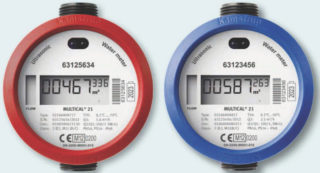
When buying, selecting a household meter, be sure to pay attention to the following parameters:
- Destination type. If you need a device for hot water, take SGW. It is enclosed in a red box. If you need a water meter for a cold one, buy a device in a blue case. There are universal meters in a white casing. They can be used on both types of drinking water.
- Mechanism type. For apartments, a standard tachometer is more often used. Better to take a multi-jet vane or turbine. They are more accurate.
- Maximum accuracy of the received data. It is better to give preference to ultrasonic or electromagnetic water meters.
- Price. Depends on the manufacturer, the type of device, and also on the "dryness" or "wetness" of the device.
- The presence of an anti-magnetic system. Allows to exclude unintentional influence of the magnet on the device and distortion of the final results.
If you plan to install a mechanical meter, it should be borne in mind that a vane meter can be mounted on a pipe with a diameter of up to 38 mm, while a turbine meter is designed for DN 40 mm.
It is also better to select a water meter according to the consumption of funds for its further maintenance (verification, repair). A too complex device will require more investment.
Installation methods
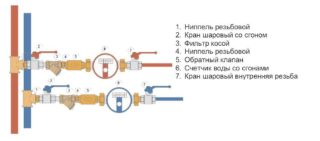
After the type of device is selected, you need to mount it. There are three ways to install a water meter:
- vertical;
- horizontal;
- diagonal.
It all depends on the location of the water supply section on which the meter will be installed. The main thing is that the device has free access to take readings. The drinking water meter is installed immediately after the pipeline enters the apartment from the common riser, but to the branching points of the liquid supply to the plumbing fixtures.
Installation is carried out only in such a way that the water flow moves according to the arrow indicated on the meter. Install the water meter in this order:
- stopcock;
- coarse filter;
- metering device for water consumption with an arrow in the direction of its supply to an apartment / house;
- check valve at the outlet.
First, you need to collect all the water supply units into a single structure according to the above scheme. Then a section of the pipe is cut along its length. Threads are cut at the ends of the tube and clamping nuts are placed. After that, the counter is installed. The entire block is secured with threaded nuts.
If the master mounts the SGV, you need to additionally purchase paranitic gaskets. They withstand high DHW temperatures well. For a cold system, it is best to choose standard rubber gaskets.
After installation, the device must be put into operation. To do this, you should invite an employee of the management company who will seal the meter, take its initial readings, and register them. They will be the reference point.
Operation and maintenance
The meter is removed normally only in case of obvious violations of its operation (the presence of leaks, inaccuracy of the displayed data, the shelf life of the metering device has come to an end and it is time to change the device) or when the calibration is scheduled. As a rule, for SGV this period is every 4 years. For a cold liquid water device - 6 years.
You should not install metering devices SGV / SHV with a magnet or remote control. The controller will see this when registering the meter and will at least require a replacement. In the worst case, the owner may face penalties.
The cost of water metering devices
The price of a cold or hot water meter varies depending on the type of device mechanism and on its manufacturer. Average prices in Moscow:
- The device of the Russian company Meter (universal) - 585 rubles.
- Universal water meter with pulse output DU ½ - 590 rubles.
- Betar SGV-15 device - 565 rubles.
- Flanged turbine water meter STVX-50 (DN 50 mm) Stream (industrial) - 11 600 rubles.
- Industrial water meter STVKh-100 - 11,050 rubles.
- Industrial device Betar SVMT - (DN 50 mm) 10 400 rubles.
- Household ultrasonic water meter - from 19,535 rubles.
- Electromagnetic water meter "Vzlyot" DN 15 mm - 15 900.
Based on the above examples, the most optimal class of devices for the price are mechanical, impulse. They are easy to install and maintain.

